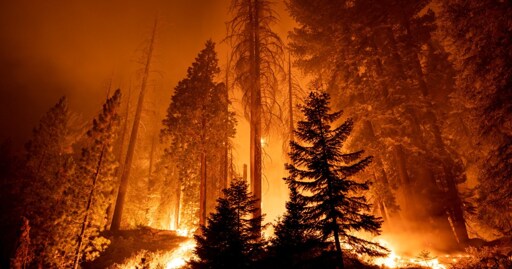Donald Trump is coming for the “holy grail” of climate regulations. As multiple media outlets reported this week, the administration plans to roll back the “endangerment finding,” an Obama-era Environmental Protection Agency decision at the center of the government’s ability to address climate change.
On paper, the endangerment finding states that greenhouse gases like methane and carbon dioxide pose a risk to the public’s health and well-being. That may sound obvious enough. But in practice, it’s one of the agency’s most important decisions.
That’s thanks to the landmark 2007 Supreme Court ruling in Massachusetts v. EPA, which found that the agency not only has the authority to regulate greenhouse gases under the Clean Air Act, but the obligation to do so, if it determines the pollutants pose a health hazard. In 2009, backed by an overwhelming body of science, the endangerment finding did just that.
Now, the Trump administration reportedly plans to throw out the finding, stripping the EPA of its central role in regulating emissions from vehicle tailpipes, power plants, and more. If the administration succeeds in court (a big if), experts say it would put the United States’—and the world’s—ability to fight climate change at risk.
To understand what rescinding the endangerment finding might mean, I called up Pat Parenteau, an emeritus law professor and senior fellow for climate policy in the Environmental Law Center at Vermont Law School, and James Milkey, a retired Massachusetts Appeals Court justice and former environmental attorney who argued Massachusetts v. EPA before the Supreme Court.
Here are a few takeaways from our conversations.
The evidence that greenhouse gases are bad for health is irrefutable.
More than two decades ago, Milkey and his team at the Massachusetts Attorney General’s office sued the Bush administration over its inaction on climate change in Massachusetts v. EPA. At the time, he recalls, they faced all sorts of challenges, but “marshaling the underlying science was not one of them.”
The science was clear. “Scientists are the most skeptical people on Earth,” he says. “And there was a scientific consensus that the accumulation of greenhouse gases in the atmosphere posed dire threats.”
Since then, those threats have only worsened. As the most recent report from the Intergovernmental Panel on Climate Change (IPCC), completed in 2023, concluded, “Human-caused climate change is already affecting many weather and climate extremes in every region across the globe. This has led to widespread adverse impacts and related losses and damages to nature and people.”
The Trump administration, in a sense, appears to recognize this. While it hasn’t released the details of its proposal publicly, reports from the New York Times, Washington Post, and other outlets indicate that Trump officials aren’t planning to repeal the endangerment finding on scientific grounds, but procedural ones, and will reportedly argue that the Obama administration overstepped its authority under the Clean Air Act.
Rescinding the “endangerment finding” won’t be easy.
On June 30, the Trump EPA sent its proposal—”Reconsideration of 2009 Endangerment Finding and Greenhouse Gas Vehicle Standards”—to the Office of Management and Budget, an EPA spokesperson told Mother Jones in an emailed statement. The proposal will be published for public comment, the spokesperson said, “once it has completed interagency review and been signed by the Administrator.”
After it’s finalized, expect “lawsuits galore,” Parenteau says, whether from attorneys general in blue states, public health groups, or climate nonprofits.
“God help us,” Parenteau says, “because there are not five votes to uphold.”
From there, it could take years—possibly the rest of the Trump administration’s term in office, according to Parenteau—for the courts to sort out the lawsuits. Ultimately, the question is likely to go to the Supreme Court. If the court also decides to reconsider Massachusetts v. EPA, the foundation for the endangerment finding, “God help us,” says Parenteau, “because there are not five votes to uphold [the ruling].”
And in the meantime, if EPA rolls back other rules based on the endangerment finding—like the Biden administration’s efforts to curb tailpipe emissions and encourage the transition to electric vehicles—the administration is likely to face even more lawsuits, Parenteau says: “Litigation, litigation, litigation, all the time, everywhere, all at once.”
It could also backfire.
As Parenteau wrote in the Conversation in March, throwing out the endangerment finding might not be all good news for Big Oil.
Across the country, Parenteau explains, cities and states have sued fossil fuel companies in dozens of lawsuits over damage caused by climate change. In response, the companies have argued that the federal Clean Air Act supersedes the state lawsuits. But if Trump’s repeal of the endangerment finding succeeds, Parenteau says, and greenhouse gas emissions aren’t regulated under the Act, that could “undercut” the companies’ arguments.
“You’ve got to be careful what you ask for in law,” he says, “because you never can be sure what the unintended consequences are going to be.”
Win or lose, Trump has signaled no intention to regulate greenhouse gas emissions.
When I asked Milkey how a challenge to the endangerment finding might play out in court, he didn’t think Team Trump would have much of a chance, at least on the scientific front. “But the scary part is,” Milkey says, “from their perspective, I don’t think it matters.”
“The damage is being done regardless of who wins the ultimate legal fight.”
As the legal conflict rolls on, the administration may go years, potentially, without implementing any sort of climate regulation (or enforcing existing ones). “It’s parallel to the Trump administration illegally pulling research grants from universities—the damage is being done,” Milkey says, “regardless of who wins the ultimate legal fight.”
That would set the country back on climate action at a time when we can’t afford to delay. The United States is the second-leading emitter of greenhouse gases, after China, in the world. If we abandon any effort to reduce emissions, Parenteau warns, the world won’t come close to achieving the goals of the Paris Agreement—limiting warming to 2 degrees Celsius above pre-industrial levels, let alone a less damaging 1.5 degrees. “That’s the cascading effect of this,” Parenteau says, “we cripple the world’s ability to create anything approaching a livable planet.”
“Many areas here and abroad are well on their way to becoming uninhabitable before our eyes,” Milkey says, echoing Parenteau. “People are dying. There are 100 million people suffering under a heat dome in the United States. So what makes the current proposal by EPA so astonishing to me is its sheer audacity.” When the country’s top environmental agency ignores those threats in the face of clear science, he says, “It’s not an exaggeration to call it another Big Lie.”
From Mother Jones via this RSS feed


